| Article ID | Journal | Published Year | Pages | File Type |
|---|---|---|---|---|
| 230377 | The Journal of Supercritical Fluids | 2015 | 9 Pages |
•Numerical study of heat transfer of supercritical CO2 in helically coiled tubes.•The SST model gives the best prediction to the heat transfer coefficient.•The parameter of Gr/Re2.7 cannot represent the influence of buoyancy.•The buoyancy changes the orientation of the secondary flow and flow fields.
Numerical simulation on heat transfer of supercritical CO2 in heated helically coiled tubes is performed to evaluate the performance of turbulence models in predicting heat transfer of supercritical CO2 in the helically coiled tube, and to help better understanding the heat transfer mechanism. All turbulence models yield similar tendencies in heat transfer coefficient in the helically coiled tube. The SST (shear-stress transport) model gives the best prediction to the experimental data due to accurate predictions of flow separation under adverse pressure gradients. The parameter of Gr/Re2.7 is incapable of predicting the buoyancy effect onset of supercritical CO2 in the helically coiled tube. The turbulent Prandtl number has little influence on the calculated heat transfer coefficient.
Graphical abstractFigure optionsDownload full-size imageDownload as PowerPoint slide
